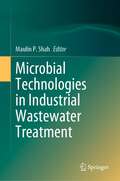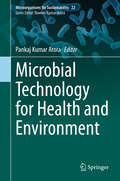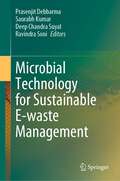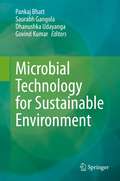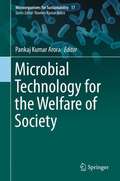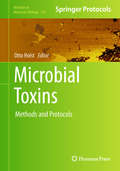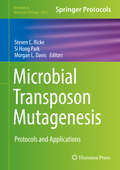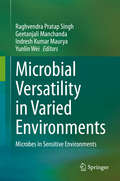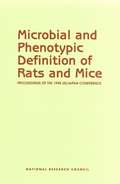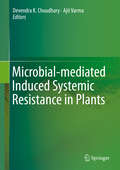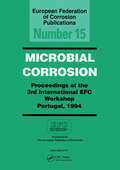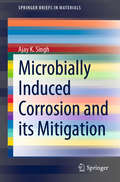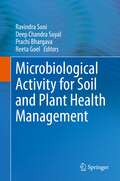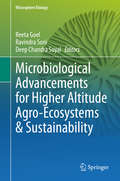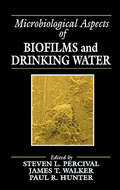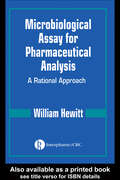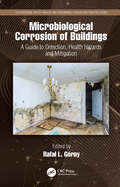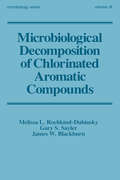- Table View
- List View
Microbial Technologies in Advanced Biofuels Production
by Patrick C. HallenbeckConcerns over dwindling fossil fuel reserves and impending climate changes have focused attention worldwide on the need to discover alternative, sustainable energy sources and fuels. Biofuels, already produced on a massive industrial scale, are seen as one answer to these problems. However, very real concerns over the effects of biofuel production on food supplies, with some of ht recent increases in worldwide food costs attributable to biofuel production, have lead to the realization that new, non-food substrates for biofuel production must be bought online. This book is an authoritative, comprehensive, up-to-date review of the various options under development for the production of advanced biofuels as alternative energy sources. A general overview and introductory chapters for each section place the field in the context as well as provide essential basic notions for the more general reader. Accomplished, internationally recognized experts carrying out research on individual focus areas contribute specific technical chapters detailing present progress and future prospects.
Microbial Technologies in Industrial Wastewater Treatment
by Maulin P. ShahMicrobial technology using live, naturally occurring microorganisms in industrial wastewater treatment, is the most effective and innovative method to degrade environmental pollutants such as heavy metals, radionuclides, xenobiotic compounds, organic waste, and pesticides, or to prevent their contamination of the environment. The technology includes several techniques such as biostimulation, biogeneration, bioaccumulation, and biosorption. This book describes the limitations and challenges associated with some generally accepted bioremediation strategies and evaluates the possible applications of these corrective strategies to eliminate toxic pollutants from the environment.The environmental contamination by both natural and anthropogenic sources is, nowadays, an international concern. To decontaminate soils, sediments, and water polluted by anthropogenic activities, scientists and technologists have developed various technologies over the years; however, not only do we have to pay a high cost for physical and chemical environmental technologies but also they sometimes are not ecological or safe. Therefore, we have realized the necessity to develop viable technologies that use microbes and plants to avoid these issues.This book is designed for engineers, scientists, and other professionals who are seeking introductory and advanced knowledge of the principles of nanotechnology, and those who work or are interested in the environmental microbiology or bioremediation field.
Microbial Technology for Health and Environment (Microorganisms for Sustainability #22)
by Pankaj Kumar AroraRampant industrialization has caused high levels of contamination by various toxic chemicals in our water bodies, which is a matter of concern in terms of ecosystems, as well as human and animal health. Polluted wastewater can contaminate drinking water and is also is a causal factor for bio-magnification of heavy metals into our food cycle. In the last decade, several methodologies have been adopted to clean the wastewaters, and among these, microbial remediation has emerged as an effective technology. Several variants of microbial technologies have been developed for wastewater treatment and biodegradation specific to the industry, type of waste and toxicity of the chemicals.This book describes the recent advances in microbial degradation and microbial remediation of various xenobiotic compounds in soil and wastewater. It also explains various modern microbial technologies for biodegradation and wastewater treatment. It covers various microbial technologies for wastewater treatment, biodegradation, bioremediation and solid waste management. Gathering contributions from leading international it focuses on the status quo in industrial wastewater treatment and its biodegradation.The book is intended for researchers in the field of industrial wastewater, students of environmental sciences and practitioners in water pollution abatement.
Microbial Technology for Sustainable E-waste Management
by Ravindra Soni Deep Chandra Suyal Saurabh Kumar Prasenjit DebbarmaThis book, besides discussing challenges and opportunities, will reveal the microbe-metal interactions and strategies for e-waste remediation in different ecosystems. It will unveil the recent biotechnological advancement and microbiological approach to sustainable biorecycling of e-waste such as bioleaching for heavy metal extraction, valorization of precious metal, biodegradation of e-plastic, the role of the diverse microbial community in e-waste remediation, genetically engineered microbes for e-waste management, the importance of microbial exopolysaccharides in metal biosorption, next-generation technologies, omics-based technologies etc. It also holds the promise to discuss the conservation, utilization and cataloging indigenous microbes in e-waste-polluted niches and promising hybrid technology for sustainable e-waste management.Revolution in the area of information technology and communication is constantly evolving due to scientific research and development. Concurrently, the production of new electrical and electronic equipment also thus uplifting in this era of revolution. These technological advancements certainly have problematic consequences which is the rise of huge amounts of electronic obsoletes or electronic waste (e-waste). Improper management of both hazardous and nonhazardous substances of e-waste led to a major concern in our digital society and environment. Therefore, a sustainable approach including microbial candidates to tackle e-waste is the need of the hour.Nevertheless, the continuous demand for new-generation gadgets and electronics set this high-tech evolution to a new frontier in the last few years. With this continuing trend of technological development, e-waste is expanding exponentially worldwide. In the year of 2019, the worldwide generation of e-waste was approximately 53.6 Mt, of which only about 17.4% of e-waste was collected and recycled, and the other 82.6% was not even documented. E-waste contains various heterogeneous waste complexes such as metals (60%), blends of many polymers (30%) and halogenated compounds, radioactive elements and other pollutants (10%), respectively. The sustainable, efficient, and economic management of e-waste is thus, a challenging task today and in the coming decades. Conventional techniques such as the use of chemicals, incineration and informal ways of e-waste dismantling trigger serious health risks and contamination to the human population and environment, respectively due to the liberation of toxic and hazardous substances from the waste. In this context, bio-candidates especially microorganisms could be sharp-edged biological recycling tools to manage e-waste sustainably. As microbes are omnipresent and diverse in their physiology and functional aspects, they offer a wide range of bioremediation.
Microbial Technology for Sustainable Environment
by Pankaj Bhatt Saurabh Gangola Dhanushka Udayanga Govind KumarMicroorganisms are ubiquitous on earth. These microorganisms are able to perform various functions in the environment. Microbial applications are used as biofertilizers, bioremediation, biofortification and other sustainable approaches of environmental development. Indigenous microbial cultures have the potential to perform various functions that are beneficial to achieve the sustainable goals. To date, different strains have been commercialized for the industrial and common applications for the sustainable environment. This book will cover different aspects of microbial technology for sustainable development.
Microbial Technology for the Welfare of Society (Microorganisms for Sustainability #17)
by Pankaj Kumar AroraThis book describes various aspects of modern microbiology including microbial enzymes, secondary metabolites, next-generation sequencing, microbial-based biopesticides, microbial-based cancer therapies, biodiesel, and microbial products from fermentation, biodegradation, bioremediation and wastewater treatment. Further, it explains how and why microbes play an important role in preserving the welfare of living beings and the environment. Many bacteria play a significant part in cleaning our environment by detoxifying various xenobiotic compounds, while several microbes produce secondary metabolites that are useful to human beings. The book is divided into 15 chapters that cover various aspects of microorganism-based biotechnology, including recent methodologies such as advanced molecular techniques, as well developments in classical microbiological techniques. The authors also explain how the latest and classical techniques are being used in modern-day microbial biotechnology. All chapters were written by experts from prominent universities, research laboratories, and institutes around the globe. Above all, they focus on recent advances in microbial technology that promote the welfare of living beings and the environment.
Microbial Toxins
by Otto HolstInterest in the field of microbial toxins is ever growing and spreading across a broad spectrum of scientific disciplines. In an effort to supplement the available reference texts on toxins, Microbial Toxins: Methods and Protocols includes protocols on mold fungus toxins, with some focus on aflatoxins. Intended to support a wide variety of researchers, Microbial Toxins: Methods and Protocols presents the reader with biological, chemical, physical, and medical approaches, as well as state-of-the-art research techniques. Divided into three convenient sections, this detailed volume covers bacterial protein toxins, endotoxins, and mold fungus toxins. Written in the highly successful Methods in Molecular BiologyTM series format, chapters contain introductions to their respective topics, lists of the necessary materials and reagents, step-by-step, readily reproducible laboratory protocols, and notes on troubleshooting and avoiding known pitfalls. Authoritative and accessible, Microbial Toxins: Methods and Protocols seeks to serve both professionals and novices with its well-honed methodologies in an effort to further our knowledge of this essential field.
Microbial Toxins in Food Systems: Causes, Mechanisms, Complications, and Metabolism
by Abdel Moneim Elhadi Sulieman Nawaf Ibrahim AlshammariWhen our food items become contaminated with pathogenic microorganisms, these microorganisms secrete microbial toxins which promote infection by attacking the host tissue’s immune system, thereby leading to foodborne intoxication, or poisoning, in consumers. Because these toxic microorganisms are not typically identifiable by taste, smell or sight, it is crucial to the safety of our food systems that they be detected through microbial testing. As the title suggests, Microbial Toxins: Causes, Mechanisms, Complications and Metabolism is a comprehensive overview of the life of these toxins from their pathogenesis through to their implications for human and environmental health. Including examples of salmonella, botulism, listeria and more, as well as various mycotoxins, this text will appeal to both microbiology researchers as well as food industry professionals. Beyond foodborne illness, this text also unpacks environmental toxicology and the role of microbial toxins in the development of novel anti-cancer drugs. Emerging techniques in the detection of microbial toxins will be discussed, setting this text apart from existing books on the subject. The use of proteomics in toxin identification, for example, allows for the determination of metabolic pathways and biomarkers of pathogenicity and resistance of biotoxins. This text furthers the study of foodborne hazards and has important implications for the improvement of safety in the food industry.
Microbial Transposon Mutagenesis: Protocols and Applications (Methods in Molecular Biology #2016)
by Steven C. Ricke Si Hong Park Morgan L. DavisThis book addresses cutting-edge techniques for researching transposon mutagenesis, an approach for identifying individual gene contributions to the phenotypic characteristics of a particular microorganism. The volume begins with methods for specific microorganisms and include protocols for individual microorganisms ranging from pathogens such as Salmonella to Bifidobacterium, a microorganism considered beneficial to humans and animals. The final section addresses more general protocols including plasmid transfer and bioinformatic tools as well as novel applications of transposon methodologies such as transposon-aided capture of antibiotic resistant plasmids. Written for the highly successful Methods in Molecular Biology series, chapters include introductions to their respective topics, lists of the necessary materials and reagents, step-by-step, readily reproducible laboratory protocols, and tips on troubleshooting and avoiding known pitfalls. Authoritative and practical, Microbial Transposon Mutagenesis: Protocols and Applications serves as a valuable reference for scientists seeking to apply transposon mutagenesis to microbial genetic analyses and functionality.
Microbial Versatility in Varied Environments: Microbes in Sensitive Environments
by Raghvendra Pratap Singh Geetanjali Manchanda Indresh Kumar Maurya Yunlin WeiThe book compiles the latest studies on microorganisms thriving in extreme conditions. Microbes have been found in extremely high and low temperatures, highly acidic to saline conditions, from deserts to the Dead sea, from hot-springs to underwater hydrothermal vents- the diversity is incredible. The various chapters highlight the microbial life and describe the mechanisms of tolerance to these harsh conditions, and show how an understanding of these phenomena can help us exploit the microbes in biotechnology. The theme of the book is highly significant since life in these environments can give vital clues about the origin and evolution of life on earth, as a lot of these conditions simulate the environment present billions of years ago. Additionally, the study of adaptation and survival of organisms in such environments can be important for finding life on other planets. This book shall be useful for students, researchers and course instructors interested in evolution, microbial adaptations and ecology in varied environments.
Microbial and Biotechnological Interventions in Bioremediation and Phytoremediation
by Junaid Ahmad MalikThe introduction of contaminants, due to rapid urbanisation and anthropogenic activities, into the environment causes unsteadiness, distress to the physico-chemical systems including living organisms, which possibly is threatening the dynamics of nature as well as the soil biology by producing certain xenobiotics. Hence, there is an immediate global demand for the diminution of such contaminants and xenobiotics which can otherwise adversely affect the living organisms. Some toxic xenobiotics include synthetic organochlorides such as polycyclic aromatic hydrocarbons (PAHs), and some fractions of crude oil and coal. The advancements in microbiology and biotechnology has lead to the launch of microbial biotechnology as a separate area of research and contributed dramatically to the development of the areas like agriculture, environment, biopharmaceutics, fermented foods, etc. The evolution of new metabolic pathways from natural metabolic cycles has enabled the microorganisms to degrade almost all different complex and resistant xenobiotics found on Earth. Hence, microbes stand an imperative, efficient, green and economical alternative to conventional treatment technologies. This book comprises chapters dealing with various bioremediation strategies with the help of different groups of microorganisms along with detailed graphical/ diagrammatical representations. It also focuses on the use of microbial biotechnology and highlights the recent developments in microbial biotechnology in the area of agriculture and environment. Furthermore, it contains a detailed comprehensive account for the microbial treatment technologies from unsustainable to sustainable which includes chapters prepared by professionals, several researchers, scientists, graduate students and postdoctoral fellows across the world with expertise in environmental microbiology, biotechnology, bioremediation, and environmental engineering. The research presented also highlights some of the significantly important microbial species involved in remediation, the physiology, biochemistry and the mechanisms of remediation by various microbes, and suggestions for future improvement of bioremediation technology. This book would serve as a quick reference book for graduate and postgraduate students pursuing their study in any branch of life sciences, microbiology, health sciences and environmental biotechnology as well as researchers and scientists working in laboratories and industries involved in research related to microbiology, environmental biotechnology and allied researches.
Microbial and Enzyme-Based Technology for Plastic Biodegradation (Synthesis Lectures on Chemical Engineering and Biochemical Engineering)
by Javid Ahmad Parray Wen-Jun LiImproper disposal of plastics increases micro-plastic discharge and waste to the environment. It causes growing global concern about the environmental and public health impacts of related byproducts. This book presents a safe process based on application of microbial cultures from different sources for the degradation of plastic waste to harmless products. The book begins by introducing the problem of plastic waste and its environmental impact, then moves on to describing microbial resources and the mechanism of biodegradation before presenting examples of biodegradation processes. Challenges of the microbial and enzyme based technologies for plastic biodegradation and potential research directions are also discussed.
Microbial and Phenotypic Definition of Rats and Mice: Proceedings of the 1998 US/Japan Conference
by National Research CouncilA report on the Microbial and Phenotypic Definition of Rats and Mice
Microbial life on Façades
by Georg Gärtner Wolfgang Karl HofbauerThis book provides a detailed overview of the microorganisms that form the initial growth on the exterior façades of buildings. It deals with the ecophysiological properties that characterize the basic conditions under which these microorganisms can occur on façades. In addition to an identification key for the types and forms of microorganisms, this book provides a detailed description of the individual organisms, stating their ecological range. Furthermore, the various ecological parameters are discussed in short chapters. Measures to prevent and combat the colonization of façades with microorganisms are also addressed. Specialists (architects, construction experts), builders, scientists and master students can find all the information they need on facade algae and fungi here.
Microbial products for future industrialization (Interdisciplinary Biotechnological Advances)
by Angana Sarkar Idris Adewale AhmedThis book “Microbial Products for Future Industrialization” focuses on the exploitation of various advanced microbial and molecular biology technologies and their associated processes, especially the microbial-molecular-chemical nexus, for the future industrialization of emerging new microbial products. The descriptions given in its chapters take the reader through an entire journey of new emerging microbial products from lab to industry and provide new information that has not yet been fully exploited for future industrialization steps. This volume is a great resource for readers seeking a more comprehensive material covering the technical, economic, and societal aspects that impact bioprocessing of microbial products at the industrial level along with biotechnological intervention for better production of microbial products in near future. This book also encompasses advanced and updated information as well as future directions for young researchers and scientists, and academics who are working in the field of microbial product production related to sustainability.
Microbial-mediated Induced Systemic Resistance in Plants
by Ajit Varma Devendra K. ChoudharyWith a focus on food safety, this book highlights the importance of microbes in sustainable agriculture. Plants, sessile organisms that are considered as primary producers in the ecosystem and communicate with above- and below-ground communities that consist of microbes, insects, and other vertebrate and invertebrate animals, are subjected to various kinds of stress. Broadly speaking, these can be subdivided into abiotic and biotic stresses. Plants have evolved to develop elaborate mechanisms for coping with and adapting to the environmental stresses.Among other stresses, habitat-imposed biotic stress is one serious condition causing major problems for crop productivity. Most plants employ plant-growth-promoting microorganisms (PGPMs) to combat and protect themselves from stresses and also for better growth.PGPMs are bacteria associated with plant roots and they augment plant productivity and immunity. They are also defined as root-colonizing bacteria that have beneficial effects on plant growth and development. Remarkably, PGPMs including mycorrhizae, rhizobia, and rhizobacteria (Acinetobacter, Agrobacterium, Arthrobacter, Azospirillum, Bacillus, Bradyrhizobium, Frankia, Pseudomonas, Rhizobium, Serratia, Thiobacillus) form associations with plant roots and can promote plant growth by increasing plants’ access to soil minerals and protecting them against pathogens.To combat the pathogens causing different diseases and other biotic stresses, PGPMs produce a higher level of resistance in addition to plants’ indigenous immune systems in the form of induced systemic resistance (ISR).The ISR elicited by PGPMs has suppressed plant diseases caused by a range of pathogens in both the greenhouse and field. As such, the role of these microbes can no longer be ignored for sustainable agriculture.Today, PGPMs are also utilized in the form of bio-fertilizers to increase plant productivity. However, the use of PGPMs requires a precise understanding of the interactions between plants and microbes, between microbes and microbiota, and how biotic factors influence these relationships. Consequently, continued research is needed to develop new approaches to boost the efficiency of PGPMs and to understand the ecological, genetic and biochemical relationships in their habitat.The book focuses on recent research concerning interactions between PGPMs and plants under biotic stress. It addresses key concerns such as –1. The response of benign microbes that benefit plants under biotic stress2. The physiological changes incurred in plants under harsh conditions3. The role of microbial determinants in promoting plant growth under biotic stressThe book focuses on a range of aspects related to PGPMs such as their mode of action, priming of plant defence and plant growth in disease challenged crops, multifunctional bio-fertilizers, PGPM-mediated disease suppression, and the effect of PGPMs on secondary metabolites etc.The book will be a valuable asset to researchers and professionals working in the area of microbial-mediated support of plants under biotic stress.
Microbially Corrosion: 3rd International Workshop : Papers (European Federation Of Corrosion Publications)
by C.A.C. Sequeira A.K. TillerFirst published in 1995. This is the proceedings of the third international workshop on Microbial Corrosion by the European Federation of Corrosion. Split into four sections covering an Interdisciplinary Approach to Microbially Influenced Corrosion of Copper; Microbial Corrosion: Mechanisms and General Studies; Case Studies, and Microbial Corrosion: Prevention and Control.
Microbially Induced Corrosion and its Mitigation (SpringerBriefs in Materials)
by Ajay K. SinghThis brief covers case studies on Microbial Induced Corrosion (MIC) and its mitigation. After reviewing the basics of corrosion, it focuses on MIC. MIC is a special type of electrochemical corrosion in which the presence of microbes and bacteria alters the chemistry of liquid media so as to make them more corrosive. These changes are harmful to metallic equipment, processing machinery, marine vessels, etc. in an environment that is host to a wealth of microorganisms. A 2007 US survey estimated corrosion-related damages to cost $276 billion a year, roughly 50% of which are due to MIC. The industries most affected by MIC are power production, oil exploration, transportation and storage, water distribution and more generally all industries involving marine environments. However, means for effectively preventing and controlling MIC are poorly understood. As such, the book’s later chapters address various mechanisms/processes that show promise with regard to MIC mitigation. Lastly, the book discusses the strategies currently being explored to mitigate MIC using green technologies.
Microbiological Activity for Soil and Plant Health Management
by Reeta Goel Ravindra Soni Deep Chandra Suyal Prachi BhargavaPlants and the soil they grow in, are confronted with severe biotic and abiotic stresses viz. nutrient starvation, salt stress, drought, flooding, xenobiotic contamination, in order to sustain in an ecosystem. They also shape the microbial composition in their vicinity by modulating their secretions. This book discusses the pressing demand for novel and potential microorganisms to support an environment-friendly and cost-effective way of stress management in the plants. The book summarizes the processes and mechanisms involved in microbe-assisted plant and soil stress management. It discusses the challenges and opportunities in the application of microbial interactions in plant health. It describes in detail the nutrient dynamics of different soil systems. It includes important topics like agriculturally important genes and enzymes, rhizosphere modeling & engineering, genetically engineered bio-inoculants etc. It also talks about the application of next-generation technologies, omics and nano-based technologies. In the recent years, more than 50% of agricultural production relies on chemical fertilizers, leading to serious health issues and environmental concerns. This book provides natural solutions to these environmental concerns. This book is useful for researchers and students in the field of microbiology, agriculture, soil biology and plant sciences.
Microbiological Advancements for Higher Altitude Agro-Ecosystems & Sustainability (Rhizosphere Biology)
by Reeta Goel Ravindra Soni Deep Chandra SuyalThe book explores the challenges and opportunities associated with high-altitude agro-ecosystems and the factors that influence them. It discusses the various indigenous agricultural practices and approaches, as well as the microbiology of mountain & hill agro-ecosystems, providing a comprehensive overview of the various factors that control the microbiome at high altitudes.The contributions examine microbiological advances, such as use of “omics” technologies for hill agriculture and environmental sustainability, and explore the use of nanotechnology for agricultural and environmental sustainability at higher altitudes. The book also describes various aspects of low-temperature microbiology in the context of high-altitude farming and environmental sustainability.
Microbiological Aspects of Biofilms and Drinking Water
by Steven Lane Percival James Taggari Walker Paul R. HunterThe development of biofilms and their role in public health - particularly drinking water - is often overlooked. Ideal for anyone interested in water related issues, Microbiological Aspects of Biofilms and Drinking Water presents an overview of the public health effects associated with drinking water. It highlights the microbiological aspects relat
Microbiological Assay for Pharmaceutical Analysis: A Rational Approach
by William HewittA user-friendly guide for the evaluation of microbiological assays, this book provides a lucid explanation of the sources of error in microbiological assay and helps analysts choose efficient assay designs that will minimize those sources of error. The author discusses microbiological assay as a branch of pharmaceutical analysis and distinguishes it from biological assay in general. He draws attention to the microbiological aspects that may not be so obvious to the chemical analyst and to the analytical aspects that may not be so obvious to the microbiologist. The book expands on the guidance given in pharmacopoeias and helps readers choose the assay design most appropriate for the purpose of their assay.
Microbiological Contamination Control in Pharmaceutical Clean Rooms
by Nigel HallsContamination control in pharmaceutical clean rooms has developed from a jumble of science and engineering, knowledge of what has worked well or badly in the past, dependent upon the technology available at the time the clean room was built and subsequent technological developments. Surrounding it all is a blanket of regulations. Taking a multidisc
Microbiological Corrosion of Buildings: A Guide to Detection, Health Hazards, and Mitigation (Occupational Safety, Health, and Ergonomics)
by Rafał L. GórnyEnvironmental stress caused by water continuously exposes buildings to microbial colonization. This is highly evident when both minor dampness and mass flooding occur. The text describes how microbiological corrosion of buildings and the structures and substances derived from these hazards are responsible for adverse health effects on people exposed to these contaminated environments. Microbiological Corrosion of Buildings: A Guide to Detection, Health Hazards, and Mitigation describes the key elements and methods for neutralising and removing microbiological contamination, and the operating algorithm for checking the effectiveness of preventative solutions. Ideal for construction engineers, microbiologists and professionals in the field. Features: Latest methods for detection of indoor microbial hazards Identifies the tools needed for natural, non-destructive and non-invasive methods of bio-corrosion removal Describes the social and health problems associated with exposure to microbiological hazards Provides case studies and examples of microorganisms responsible for microbial corrosion. ‘Climate change and the associated adverse effects, such as floods and whirlwinds, make the problem of microbiological corrosion of buildings that generates health risks and economic losses on a global scale, the focus of science and technology. The monograph presents a complex problem of building bio-corrosion, that requires knowledge of the distant fields of microbiology and building technology, for the use of both scientists and practitioners. This pioneering work of an interdisciplinary nature harmoniously combines knowledge on specific microbiological issues relating to the process of bio-corrosion and the associated health risks with detailed issues of construction technology concerning the prevention of bio-corrosion and its removal. The authors succeeded in combining a very high scientific level in the monograph with an accessible and understandable presentation of complex problems. The extensive references, ranging from "classical" items from many years ago to the most recent articles presenting the state of the art in this field, are worth emphasising.’ —Prof. Jacek Dutkiewicz, Ph.D., D.Sc., Institute of Rural Health in Lublin
Microbiological Decomposition of Chlorinated Aromatic Compounds
by Melissa L. Rochkind-Dubins Gary S. Sayler James W. BlackburnThis book is intended to be a general reference for environmental decision makers who are interested in the fate of chlorinated aromatic compounds with respect to microbial activity. It includes reviews of microbial physiology, genetics, and methods of biodegradation assessment.

